We are all helplessly in love with Golden Retrievers! Oozing contentment, affection, and zest for life, these fluffy balls of sunshine brighten the world just by being in it. As they mature, though, you might encounter their rowdy and rambunctious side sometimes, which makes them more difficult to train than many pet parents could expect.
Understanding that, we decided to write this detailed guide to training golden retriever! In this read, our team of experts will reveal their most effective training methods, behavioral problems, and things that might shock you when begin training a Goldie. Read on to find out something those breeders never tell you!
When to Start Training Your Golden Retriever?

Training a Golden Retriever can begin as early as 8 weeks old, but it’s important to adjust your expectations and training methods according to your dog’s age and developmental stage:
| Age Range | Training Focus | Key Activities |
| 8-12 weeks | Basic socialization and introduction | – Expose to various people, animals, and environments
– Introduce simple commands (sit, come, name) – Begin house training |
| 3-6 months | Expanding obedience and leash training | – Introduce complex commands (stay, down, leave it)
– Start leash training- – Continue diverse socialization |
| 6-12 months | Reinforcement and advanced training | – Increase duration and reliability of commands
– Teach advanced commands (heel, off-leash recall) – Begin specialized training (e.g., agility, therapy work) |
| 1 year and beyond | Ongoing development and refinement | – Regular reinforcement of learned behaviors
– Pursue complex training goals – Address any emerging behavioral issue |
How to Train a Golden Retriever: Some Basic Tips
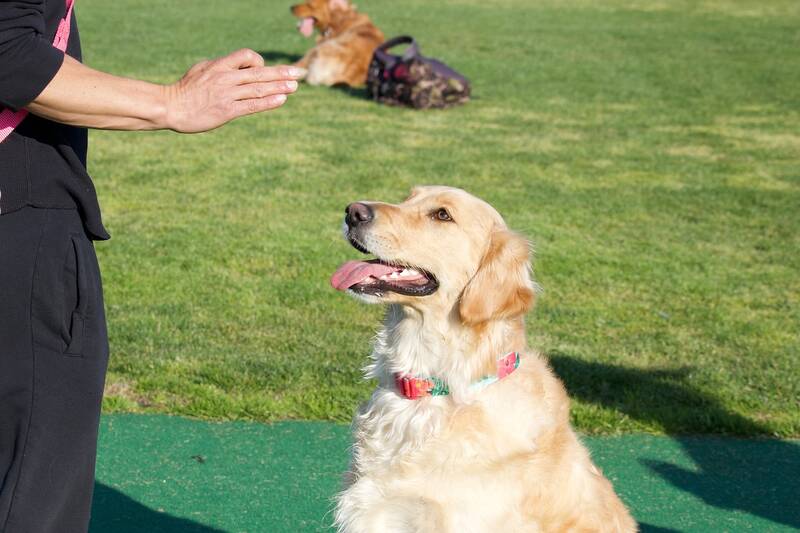
Golden Retrievers are noted for their intelligence, loyalty, and eagerness to please, making them one of the most easily trained dog breeds. However, training your dog demands persistence, patience, and a thorough grasp of its needs. Here are some basic hints for efficiently training your Golden Retriever:
Tip #1: Gather the Essential Equipment
Now that you’ve decided on the right time to start the training class for your beloved pup, it’s time to gather the necessary supplies and get ready for the fun! For your preference, our team has compiled a list of what you might need:
- Collar and leash: Choose a comfortable, well-fitting collar and a sturdy leash appropriate for your dog’s size.
- Treats: Select high-value treats that your dog finds particularly enticing for training sessions. These could include small pieces of cooked chicken, cheese, or commercial training treats.
- Clicker (optional): If you plan to use clicker training, invest in a quality clicker.
- Toys: Have a variety of toys available for reward and motivation during training sessions.
- Crate: A properly sized crate is essential for house training and providing a safe space for your dog.
- Training pads: These can be helpful during the initial stages of house training.
Tip #2: Creating an Ideal Training Environment
The environment in which you train your Golden Retriever can significantly impact the success of your sessions. Thus, we highly recommend preparing the training environment beforehand:
- Start in a quiet, distraction-free area: Begin training in a calm environment where your dog can focus solely on you and the task at hand.
- Gradually introduce distractions: As your dog masters command in a controlled environment, slowly introduce more distractions to generalize the behaviors.
- Use various locations: Practice commands in different rooms of your house, in your yard, and eventually in public spaces to ensure your dog can perform regardless of the setting.
- Ensure comfort: Make sure the training area is comfortable for your dog, with appropriate temperature and access to water.
Tip #3: Make Training Fun!
At my home, training is not a daily task. Rather, it’s a family bonding time. After all, why would you want to teach and your furry friend want to learn if it’s not enjoyable?
Keep each training session short to avoid boredom and frustration. Maintain a relaxing, cheerful demeanor, and always be fair to your dog. The training process will be much more productive if both of you are having fun and enjoying each other’s company.
Tip #4: Don’t Forget the Importance of Positive Reinforcement
Rewarding behavior is defined as training using rewards like praise, treats, or toys. To put it simply, you give your dog something they love when they perform the desired action. Simple, isn’t it?
For years, this has always been considered the best way for our furry friends to learn. Scientists proved that when your dog does something and gets a reward, their mind will associate the two and are more likely to repeat the action in the future. We have a few things to note when you use positive reinforcement, though:
- Timing is key: For this method, choosing the right time to give rewards is essential. If the reward is not given immediately after they perform the desired behavior, your dog won’t be able to link the two. For instance, when you teach your Goldie to sit but give him a treat after he has stood back up, he might think he’s being rewarded for standing.
- Be consistent: If everyone in the household doesn’t use the same cue, your Golden Retriever might be confused. Our suggestion is to agree on a list of cues and have your family members familiar with it.
- Use different rewards for different behaviors: For example, soft treats that smell like sausage, chicken, or cheese should be used as the “ultimate” reward when your Goldie gets something right in environments with more distractions. Less exciting treats, such as dry veggies, can be used when it’s easier for them to get it right.
- Don’t forget how rewarding attention can be: Golden Retrievers are prone to obesity, so rewarding with treats is not always a good option. Most dogs will feel good when we pet them and talk to them, so you can also reward them with praise and attention when they behave nicely.
Basic Obedience Training For Golden Retrievers
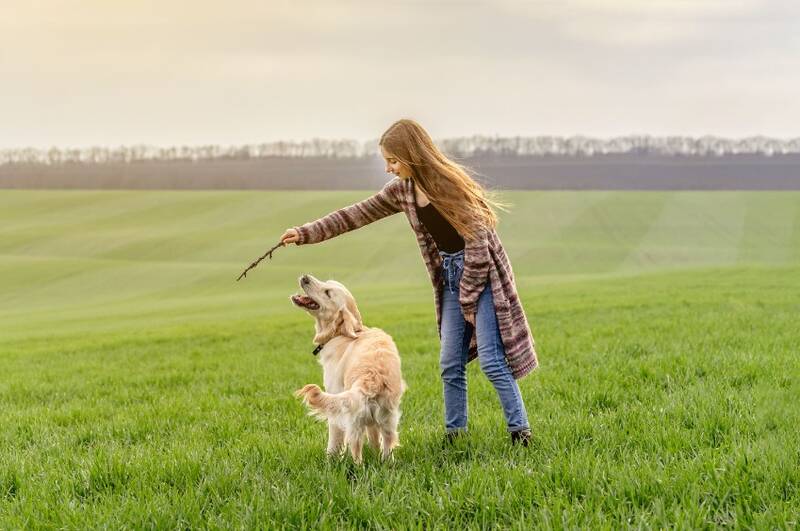
Golden Retrievers make ideal candidates for obedience training. Teaching your Golden Retriever with basic commands at a young age will help him establish good manners and enhance your bond. This is a guide on basic obedience training for Golden Retrievers.
Teaching Essential Commands
- Sit:
-
-
- Hold a treat close to your dog’s nose.
- Slowly move the treat up and back over their head.
- As their head tilts back to follow the treat, their bottom will naturally lower.
- As soon as they sit, mark the behavior and reward.
-
- Stay:
-
-
- Ask your dog to sit.
- Open your palm in front of you and say “Stay.”
- Take a step back.
- If your dog stays, mark the behavior and reward.
- Gradually increase the duration and distance.
-
- Come:
-
-
- Start in a low-distraction environment.
- Say your dog’s name followed by “come” in an enthusiastic voice.
- When they come to you, mark the behavior and reward generously.
- Practice this command on a long leash before attempting off-leash recall.
-
- Down:
-
-
- Start with your dog in a sitting position.
- Hold a treat in front of their nose, then slowly lower it to the ground.
- As they follow the treatment, their body should naturally lower into a down position.
- As soon as they’re down, mark the behavior and reward.
-
- Leave it:
-
- Place a treat on the floor and cover it with your hand.
- When your dog loses interest in your hand, mark the behavior and reward with a different treat.
- Gradually increase the difficulty by uncovering the treat and using more tempting items.
Leash Training
Leash training is one of the most basic lessons for your pup. While it’s a must if you want to get your Golden Retriever out peacefully and smoothly, it can be frustrating for first-time parents. Let’s give you a step-by-step guide on the training methods that have proven effective for many of my family dogs!
- Introduce your puppy to the least by wearing it to them indoors in a quiet environment and giving them treats.
- Teach them a sound cue that means “It’s time for food!” You can snap or use a short verbal command, such as “Food.” The step is simple: in an undistracted environment, make the sound when your Goldie is still on the leash and collar. Right after your pup pays attention to the sound, reward him with a treat.
- As your Golden Retriever runs toward you with his leash and collar, step back a bit. Then, reward him when he reaches you. Stick to the progression until your pup immediately turns to you and runs toward you when he hears the cue.
- At this stage, your fur baby should know when to come to you. After he becomes more familiar and comfortable with the leash, you can take them outdoors to practice.
Golden Retriever Puppy Potty Training
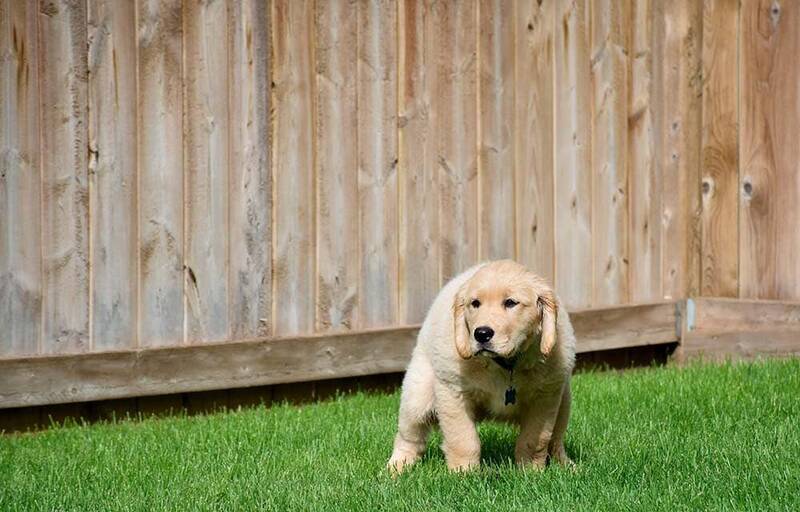
Effective house training is crucial for a harmonious life with your Golden Retriever. Follow these steps for successful house training golden retriever:
- Establish a routine:
- Take your puppy out first thing in the morning, after meals, after naps, and before bedtime.
- For young puppies, a general rule is they can hold their bladder for as many hours as they are months old, plus one (up to 8 hours).
- Choose a specific potty area:
- Always take your dog to the same spot for potty breaks.
- The scent will prompt them to eliminate.
- Use a consistent command:
- Choose a phrase like “go potty” and use it every time you take your dog out.
- Reward success:
- Praise and treat your dog immediately after they are eliminated outside.
- This positive reinforcement will encourage them to repeat the behavior.
- Supervise closely:
- When indoors, keep a close eye on your puppy for signs they need to go (sniffing, circling, whining).
- If you can’t supervise, use a crate or confined area.
- Handle accidents properly:
- If you catch your dog in the act, interrupt them and immediately take them outside.
- Never punish your dog for accidents; simply clean thoroughly to remove the scent.
- Be patient:
- House training can take several weeks to months.
- Consistency and positive reinforcement are key to success.
Other Advanced Training for Golden Retrievers
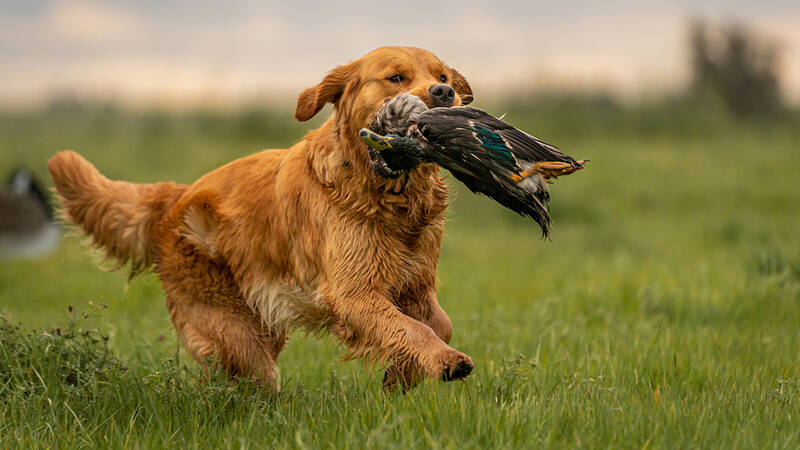
Once your Golden Retriever has mastered basic obedience, you can move on to more advanced training:
Outdoor Obedience
- Practice known commands in various outdoor settings with increasing distractions.
- Work on off-leash reliability in secure areas.
- Teach boundary training to keep your dog within designated areas of your property.
Agility Training
Golden Retrievers often excel at agility due to their athleticism and intelligence:
- Start with basic obstacles like jumps and tunnels.
- Gradually introduce more complex elements like weave poles and seesaws.
- Use positive reinforcement to encourage interaction with obstacles.
- Always prioritize safety and consult with a professional before attempting advanced agility work.
Retrieval Training
Given their heritage as hunting dogs, many Golden Retrievers have a natural affinity for retrieval:
- Begin with short, easy throws of a favorite toy.
- Teach a “hold” command to encourage your dog to keep the item in their mouth.
- Introduce a “drop it” or “give” command for releasing the item.
- Gradually increase the difficulty with longer throws and various objects.
Therapy Dog Training
Golden Retrievers’ gentle nature makes them excellent candidates for therapy work:
- Ensure your dog has rock-solid basic obedience.
- Expose them to various people, environments, and situations.
- Teach them to remain calm in exciting or stressful situations.
- Consider enrolling in a certified therapy dog program for formal training and certification.
Training For Common Behavioral Issues Of Golden Retrievers
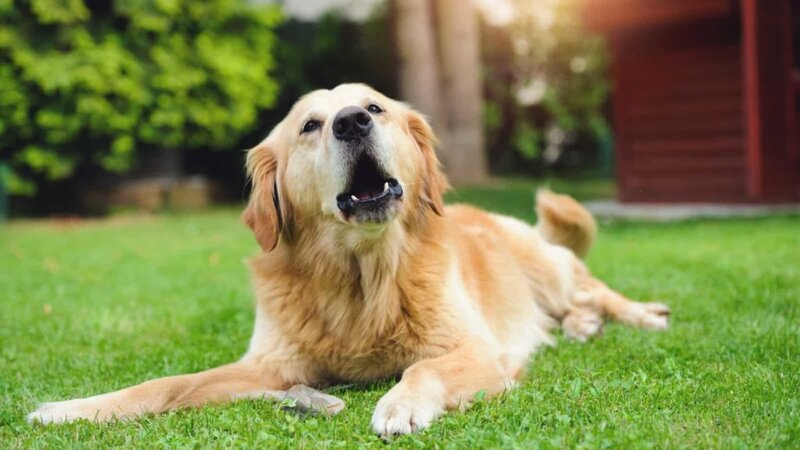
Even well-trained Golden Retrievers may develop behavioral issues. Here are some common problems and strategies to address them:
Excessive Barking
- Identify the cause (e.g., boredom, anxiety, attention-seeking, sexual hormones).
- Teach the “quiet” command using positive reinforcement.
- Provide plenty of exercise and mental stimulation to reduce boredom-related barking.
- For anxiety-related barking, work on building your dog’s confidence through training and positive experiences.
Read more >> When to Neuter Golden Retrievers?
Jumping on People
- Teach and reinforce an incompatible behavior, like sitting to greet people.
- Ask visitors to ignore your dog until all four paws are on the ground.
- Reward calm behavior around new people.
Chewing Inappropriate Items
- Provide plenty of appropriate chew toys.
- Use deterrent sprays on items you don’t want to be chewed.
- Ensure your dog gets enough physical and mental exercise to prevent boredom.
- Supervise your dog and redirect it to appropriate chew toys when necessary.
Separation Anxiety
- Gradually accustom your dog to being alone, starting with very short periods.
- Create positive associations with your departure by giving a special treat or toy.
- Keep departures and arrivals low-key to avoid reinforcing anxiety.
- Consider crate training to provide a safe, comfortable space when alone.
- For severe cases, consult with a professional dog trainer or behaviorist.
Conclusion
Training a Golden Retriever is a rewarding journey that strengthens the bond between you and your furry companion. While it requires patience, consistency, and dedication, the process is generally manageable thanks to the breed’s intelligence and eagerness to please.
Remember that every dog is unique, and what works for one may not work for another. Be prepared to adjust your approach based on your individual dog’s needs and responses. Celebrate small victories along the way, and don’t get discouraged by setbacks – they’re a normal part of the learning process.
With the right approach, plenty of positive reinforcement, and lots of love, you’ll be well on your way to raising a well-behaved, happy, and healthy Golden Retriever. The time and effort you invest in training will pay off with years of companionship with a loyal, obedient, and joyful four-legged friend.
Training A Golden Retriever FAQs
How Can I Raise My Golden Retriever to be Calm?
The best method to keep your dog calm is to allow them to release all of their energy on a daily basis. Your Golden Retriever needs no less than 30 minutes of movement every day. The Golden Retriever can engage in play for hours without stopping, and they like it!
Are Golden Retrievers Easy to Train?
Yes, Golden Retrievers are rather easy to teach. They are bright, eager to please, and rely heavily on treats and positive reinforcement. Their amiable and social character makes them eager to learn directions and tasks. However, constant training, patience, and early socialization are essential for raising a well-behaved Golden Retriever. While they can be a little exuberant, their genuine desire to learn makes them great for obedience training.
Can I Train My Golden Retrievers to be Cat-Friendly?
Golden Retrievers are generally good with cats due to their friendly and gentle nature. With proper training and early socialization, you can indeed teach your Golden Retriever to be cat-friendly, fostering a harmonious relationship between your pets. Introduce them gradually, supervise their interactions, and reward positive behavior to help your Golden Retriever learn to respect and coexist peacefully with feline companions.

As a professional writer who specializes in canine care, I have spent a significant amount of time researching and writing about Golden Retrievers. While I do not own a Golden Retriever, my considerable research and collaboration with doctors, breeders, and Golden Retriever experts has provided me with a lot of information about this incredible breed. My writing covers a wide range of topics, from food and health concerns to behavior and training, to assist owners in raising well-rounded, healthy golden retrievers. Through this website, I wish to share my knowledge and positively touch the lives of both dogs and their humans.
